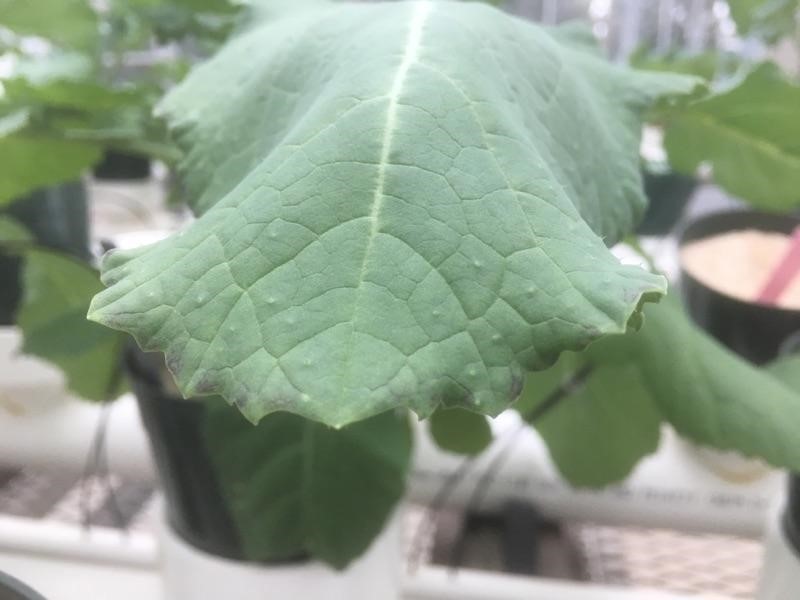Zinc Deficiency of Carinata
go.ncsu.edu/readext?520084
en Español / em Português
El inglés es el idioma de control de esta página. En la medida en que haya algún conflicto entre la traducción al inglés y la traducción, el inglés prevalece.
Al hacer clic en el enlace de traducción se activa un servicio de traducción gratuito para convertir la página al español. Al igual que con cualquier traducción por Internet, la conversión no es sensible al contexto y puede que no traduzca el texto en su significado original. NC State Extension no garantiza la exactitud del texto traducido. Por favor, tenga en cuenta que algunas aplicaciones y/o servicios pueden no funcionar como se espera cuando se traducen.
Português
Inglês é o idioma de controle desta página. Na medida que haja algum conflito entre o texto original em Inglês e a tradução, o Inglês prevalece.
Ao clicar no link de tradução, um serviço gratuito de tradução será ativado para converter a página para o Português. Como em qualquer tradução pela internet, a conversão não é sensivel ao contexto e pode não ocorrer a tradução para o significado orginal. O serviço de Extensão da Carolina do Norte (NC State Extension) não garante a exatidão do texto traduzido. Por favor, observe que algumas funções ou serviços podem não funcionar como esperado após a tradução.
English
English is the controlling language of this page. To the extent there is any conflict between the English text and the translation, English controls.
Clicking on the translation link activates a free translation service to convert the page to Spanish. As with any Internet translation, the conversion is not context-sensitive and may not translate the text to its original meaning. NC State Extension does not guarantee the accuracy of the translated text. Please note that some applications and/or services may not function as expected when translated.
Collapse ▲From the Field – Agronomy Notes
In this Brassica carinata (Ethiopian Mustard) research update, we highlight the symptoms of zinc deficiency. These images are part of a project by the Southeast Partnership for Advanced Renewables from Carinata (SPARC) to develop a diagnostic series for the identification of nutrient disorders of Carinata. Carinata is an exciting new crop in the Southeast used for a wide variety of primary and secondary agricultural products including cover crops, feedstock, high protein meal, and jet fuel. It is similar in management to canola given both canola and carinata are winter annual Brassica oilseed crops. However, carinata oil is not edible.
Diagnostic Information:
Like many other micronutrients, zinc (Zn) is responsible for many enzymatic processes in plant metabolism. Among the many functions of Zn are its structural role in RNA polymerase, protein interactions, and indole acetic acid synthesis, the principle auxin in plants which facilitates many important processes including cell division and enlargement, as well as responses to light. High phosphorus availability can induce Zn deficiencies, particularly on low Zn soils. Zn deficient plants may exhibit compensatory uptake of iron, copper, and manganese. Zn deficiencies are more common on calcareous or alkaline soils, and can be alleviated by correcting soil pH or foliar fertilization of chelated Zn.
Zinc (Zn) deficiency symptoms were observed later in growth trials than most other nutrients. This does not mean that zinc deficient conditions will not occur. Zinc is an immobile element which means that symptomology will appear on the upper foliage since it does not translocate from older to newer tissue.
Zinc deficiency manifested very late during the experiment. The carinata plants appeared large and healthy, and showing only subtle signs of stress (Fig. 1). Upon closer inspection, symptomology appeared on the mid to upper foliage as a slight paling of the leaf margin (Fig. 2). In addition to a slight yellowing or paling, the leaf margin took on a slight purple coloration on the marginal tip (Fig. 2).
More research is needed to document later stages of zinc deficiency in carinata. To ensure proper diagnosis the above material should be used in conjunction with a leaf tissue sample and/or field test.

Figure 1: The above carinata plant appeared healthy and vigorous. It had moved out of its rosette phase and into the beginning phases of elongation/bolting before zinc deficiency symptoms began to appear. ©2018 Forensic Floriculture

Figure 2: The beginning stages of zinc deficiency very late in the experiment as a marginal paleness and purpling of the leaf margin especially of the leaf tip. Note also the gall like structures on the leaf surface. When diagnosing zinc deficiency these two symptoms may be useful. ©2018 Forensic Floriculture



Key Contact Central East:
Dr. Angela Post, Department of Crop and Soil Science – angela_post@ncsu.edu
Dr. Carl Crozier, Department of Crop and Soil Science – ccrozier@ncsu.edu
Key Contact South East:
Dr. Michael Mulvaney, UF/IFAS West Florida Research and Education Center– m.mulvaney@ufl.edu
Primary Authors: Paul Cockson, Dr. Carl Crozier, Dr. Ramon Leon, Dr. Michael Mulvaney, Dr. Angela Post, and Dr. Brian E. Whipker
Project Team: NC State Univ. personnel Paul Cockson (NC State B.S. student in Agroecology), Ingram McCall (Research Technician in Horticultural Science at NC State), Dr. Carl Crozier (Professor and Extension Specialist at NC State), Dr. Ramon Leon (Assistant Professor at NC State), Dr. Angela Post (Assistant Professor and Extension Specialist NC State), and Dr. Brian Whipker (Professor of Floriculture and Plant Nutrition in Horticultural Science at NC State). Univ. of Florida personnel Dr. Michael Mulvaney (Cropping Systems Specialist at UF/IFAS West Florida Research and Education Center.
Suggested Citation:
Cockson, P.1, C. Crozier1, R. Leon1, M. Mulvaney2, A. Post1, B. Whipker1. 2018. Zinc Deficiency of Carinata. North Carolina St. Univ. Small Grains Portal – From the Field-Agronomy Notes.
1North Carolina State University
2University of Florida
Funding and Acknowledgments:
Funding for this work/study was received through USDA-NIFA Bioenergy Coordinated Agricultural Project (CAP). This material is based upon work that is supported by the National Institute of Food and Agriculture, U.S. Department of Agriculture.





